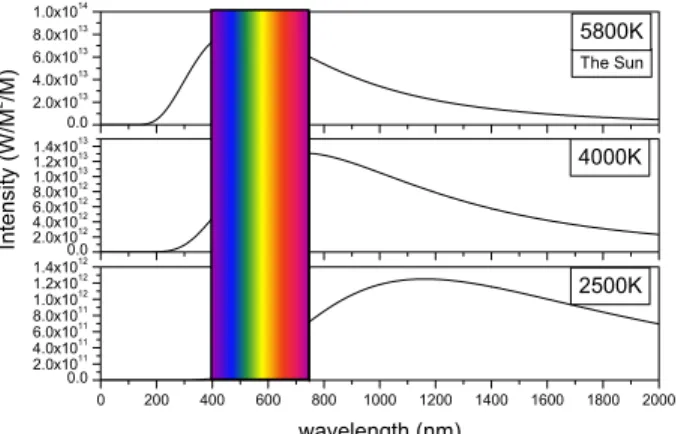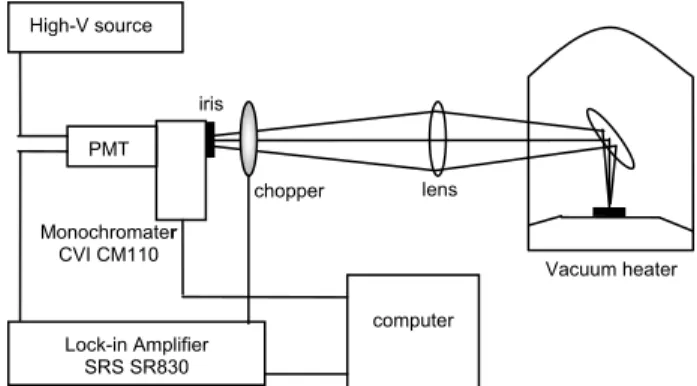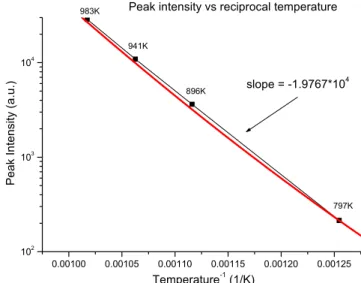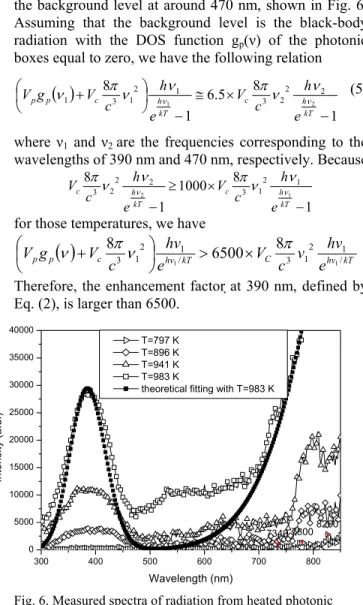Enhance the Blue-Light Emission of Black-Body Radiation with
Metallic Photonic Boxes
Cha-Hsin Chao and Ching-Fuh Lin
aa
Graduate Institute of Electro-Optical Engineering, National Taiwan University, Taipei, Taiwan,
R.O.C
*also with Graduate Institute of Electronics Engineering, and Dept. of Electrical Engineering.
Phone: 886-2-33663540, Fax: 886-2-23638247, Email:
cflin@cc.ee.ntu.edu.tw
Abstract — Black-body radiation can be modified for blue-light enhancement. Using photonic boxes of about 200 nm, the enhanced blue light has peak intensity at 390 nm and a spectral width of 90 nm, which are both temperature-independent. The spectrum is also suppressed at long-wavelength region, so the enhanced peak intensity is over 5 times stronger than the background level at 470 nm for all measured temperatures. In contrast, for usual black-body radiation at those temperatures, the intensity is over 1000 times weaker at 390 nm than above 470 nm. Other visible spectra can also be enhanced by increasing the size of photonic boxes.
Index Terms — Black-body radiation, photonic crystals, lithography, resonant cavity, cut-off wavelength, blue-light enhancement.
I. INTRODUCTION
Lighting is a very important invention for human beings. In 1879 Edison invented the light bulb [1]. The traditional light bulb can emit visible light by heating tungsten filament approximately near 2,500 K. Nevertheless, the light bulb is not a very efficient lighting device. As shown in Fig. 1, only 5% energy belongs to visible light range and most of the radiation is the thermal energy in infrared range. More thermal energy may emit in visible light only when we exceed temperature to 5000 K.
Improving lighting efficiency of light bulb is always attractive. Recent advance in research on photonics opens the possibility of light manipulation using photonic crystals [2]-[4]. Metallic photonic crystals have been shown to modify black-body radiation for the enhancement of emission in 4µm – 6µm and 1.5µm – 2.5µm range [5]-[6]. Recent advance in research on photonics further opened the possibility of light manipulation using photonic crystals [7]. However, increase of black-body radiation in the visible spectrum has not been shown due to the complex of photonic crystals and difficulty in their fabrication [8]. Here we show a very simple way to enhance black-body radiation in the blue spectrum. Using photonic boxes with a size of about 200 nm, our experiment demonstrates that
black-body radiation has significantly enhanced light emission at around 400 nm with a narrow spectral width. Other visible spectra can also be enhanced by simply increasing the size of photonic boxes. If we coat metallic photonic box outside the tungsten filament, it will help emit black-body radiation greatly at specific wavelength. The metallic photonic box is just like a resonant cavity. The EM wave oscillates in the metal cavity and then emits from the thin top metal, so we can easily design different box sizes for different wavelengths. In addition, spectrum of black-body radiation will be suppressed in long wavelength range because wavelength longer than cut-off wavelength cannot survive in a resonant cavity, just analogous to the band gap of photonic crystal except that the photonic boxes have an infinite band gap for wavelength longer than the cut-off wavelength. In addition, we can only see narrow range spectrum with particular modes of wavelengths. As a result, light intensity in the visible light band is amplified several times. If we want to observe white light, we just combine red, green, and blue three photonic boxes in the nanometer scale. No complicated materials corresponding to different visible light are needed, showing a great advantage over visible LED or OLED.
Fig. 1. Conventional blackbody radiation spectra under different temperature. 0 200 400 600 800 1000 1200 1400 1600 1800 2000 0.0 2.0x104.0x1011 11 6.0x1011 8.0x1011 1.0x1012 1.2x1012 1.4x100.012 2.0x104.0x1012 12 6.0x1012 8.0x1012 1.0x1013 1.2x1013 1.4x1013 0.0 2.0x1013 4.0x1013 6.0x1013 8.0x1013 1.0x1014 2500K In tens ity (W /M 2 /M) wavelength (nm) 4000K The Sun 5800K Proceedings of 2005 5th IEEE Conference on Nanotechnology
Nagoya, Japan, July 2005
Lock-in Amplifier SRS SR830 Vacuum heater lens Monochromater CVI CM110 PMT High-V source chopper computer iris
II. FABRICATION PROCESSES
The photonic box here is defined by a dielectric box surrounded by metal outside, so the resonant cavity is the main idea of making the metallic photonic box modify the black-body radiation. The processing steps are as follows. First a silicon wafer is used as the substrate. Then we evaporate metal and then spin on SOG (spin on glass) for the dielectric inside the box. Next IIPL (Immersion Interference PhotoLithography) using a 351 nm Argon ion laser is applied twice to create two dimensional patterns on the photoresist [9] , which has 220 nm length and 220 nm spacing, as shown in Fig 2. Then we use RIE (reactive ion etch) to vertically etch some dielectric layer with argon and CHF3 gases. Afterwards we evaporate
metal to fill the hollow regions and then remove photoresist. Finally, thin metal is evaporated on the top to cover the metallic photonic box.
Fig. 2. SEM picture of designing the metallic photonic box with IIPL to pattern the PR.
III. MEASUREMENT SETUPS
In order to heat up our sample toward high temperature without being oxidized, we put it in a vacuum chamber with the pressure near 5x10-4 Pa. The temperature can
approach 1,500 degrees C, determined by a thermal couple, as shown in Fig. 3. When the sample is heated on the graphite boat, according to the Planck’s law of blackbody radiation, we can observe that the graphite boat is white-hot. The heat is then conducted to the sample. Light emitted from the sample is directed by a mirror placed obliquely in the chamber toward the monochromator. The light is focused on the inlet of monochromater by a lens. The relative distances between the image and the source is well aligned to obtain the measurement just for the sample area. The position of the lens is adjusted to make the image formed just right on the entrance of the monochromater CVI CM110. The
photomultiplier tube (PMT) is used behind the monochromater for light detection. Lock-in Amplifier is connected with PMT. Finally, the spectrum measurement is recorded by a computer.
Fig. 3. Experiment setup of blackbody radiation spectra.
IV. THEORETICAL CALCULATION
If a body consists of many photonic boxes that do not have the same size, the resonance wavelengths will form a band with its density of states (DOS) undulated by the size distribution function. Then the band gap between the resonance peaks shrinks and may disappear if the size distribution function is broad. However, the widest band gap that extends from the largest cut-off wavelength (corresponding to the largest box) to infinite wavelength should still exist. The cases of a unique size and various sizes are shown. On the other hand, the photon statistics that favors long-wavelength spectrum [10] will cause the DOS at the cut-off wavelength to dominate light emission.
In practice, the photonic boxes cannot exist by themselves. They are surrounded by metals. The emission of light thus consists of two parts. One is the EM wave in the photonic boxes. The other is from the surrounded metal that still follows the conventional black-body radiation. Therefore, we have the total radiation given by
(
)
dv e hv v c V v g V hv n dv v g V v g V dv v kT hv C P P s C C P P / 2 3 8 ) ( ) ( ) ( ) ( ⎟ ⎠ ⎞ ⎜ ⎝ ⎛ + = × × + = π µ (1)where gp(ν) and gc(ν) are the DOS functions (per unit
volume) of the photonic boxes and the conventional black body, respectively; Vp is the total volume of the photonic
boxes, while Vc is the total volume of the surrounded
metal; is the photon statistics.
The term Vp * gp(ν) in Eq. (1) explains the black-body
radiation enhanced at the spectrum regulated by the DOS function. Let us define the enhancement factor η by
( )
8 / 8( )
/ 8 2 1 3 2 3 2 3 ⎟⎠+ ⎞ ⎜ ⎝ ⎛ = ⎟ ⎠ ⎞ ⎜ ⎝ ⎛ + = ν πν πν ν πν η c V g V c V c V g Vp p c c p p c (2) s n0.00100 0.00105 0.00110 0.00115 0.00120 0.00125 102 103 104 slope = -1.9767*104 983K 941K 896K 797K Temperature-1 (1/K) Pe ak In ten sity ( a .u .)
Peak intensity vs reciprocal temperature
300 400 500 600 700 800 0.0 5.0x103 1.0x104 1.5x104 2.0x104 2.5x104 3.0x104 Black-body radiation
without photonic boxes at 983K T=797 K T=896 K T=941 K T=983 K ra diat io n in ten sit y (a .u. ) wavelength(nm)
If the enhancement factor is much larger than 1, the modified black-body radiation might exhibit temperature-independent features characterized by the DOS function of the photonic boxes, gp(ν).
IV. EXPERIMENT RESULTS
Blackbody radiation spectrum is governed mainly by temperature, described by the Planck’s Law,
) 1 ( 2 ) , ( 5 / 2 − = hc kT e hc T E λ λ π λ (3)
where h is Planck’s constant, c is the speed of light, λ is the wavelength, k is the Boltzmann’s constant. Usually conventional black-body radiation emits mainly in visible light range only when the temperature exceeds 5000 K. However, as mentioned before, we can make use of properties of cut-off wavelength of metallic photonic resonant box to suppress long wavelength range. Cut-off wavelength is given by 2 2 2 2 m l k na klm + + = λ (4)
where n is refractive index, a is box length, and k, l, m are EM wave modes. For instance, when a = 200 nm and dielectric constant = 1.4, we get cut-off wavelength λ = 410 nm, corresponding to blue light. Wavelengths longer than this cannot exist and its energy will be transferred to shorter wavelength range. In Fig 4, our fabricated sample shows a measured peak near 400 nm with a narrow spectral width at temperatures 797K to 983K, and long-wavelengths range are suppressed greatly. The peak is amplified by approximately 6 times larger than background level in the 500 to 600nm range.
Fig. 4. Spectrum with metallic photonic box.
For comparison, the conventional black-body radiation at 983K is also plotted in Fig 4. Its intensity near 400 nm is much lower than the long-wavelength range. The photonic boxes enhance the blue light and meanwhile suppress the long-wavelength radiation, leading to the enhancement of the blue light relative to the long-wavelength spectrum for a factor of more than 5000. The spectral width is 90 nm, which is about the same for all temperatures. The spectral width is caused by the size variation of the photonic boxes due to the fabrication variation of UV lithography to pattern the photoresist. However, the spectral width does not vary with the temperature. This behavior is different from the usual black-body radiation, but is similar to the behavior of metallic photonic crystals. The emission peak and the spectral width of metallic photonic crystals are due to the periodic nature. For the photonic boxes, the peak wavelength is pinched at the resonance wavelength of the largest-number boxes and the spectral width is governed by the size variation. If the photonic boxes have a single size, we expect that the emission should have a very narrow line. We also make the comparison with the peak intensity versus various reciprocal temperatures, shown in Fig. 5. According to the Planck’s law of radiation, the radiation intensity is proportion to 1/(ehc/λkT−1). If we take
natural logarithm on both sides, we can find the slope in the semi-log plot which corresponds to the emitting wavelength.
Fig. 5. The peak intensity versus reciprocal temperature.
The peak wavelength remains at approximately 390 nm at those temperatures, which is an important feature resulting from the DOS function of the photonic boxes, as described by Eq. (1). For temperatures not above 941K,
300 400 500 600 700 800 0 5000 10000 15000 20000 25000 30000 35000 40000 7340 78008260 T=797 K T=896 K T=941 K T=983 K
theoretical fitting with T=983 K
Intensi
ty (a.u.)
Wavelength (nm)
the peak intensity at 390 nm is about 6.5 times larger than the background level at around 470 nm, shown in Fig. 6. Assuming that the background level is the black-body radiation with the DOS function gp(ν) of the photonic
boxes equal to zero, we have the following relation
( )
1 8 5 . 6 1 8 2 1 2 2 2 3 1 2 1 3 1 − × ≅ − ⎟ ⎠ ⎞ ⎜ ⎝ ⎛ + kT h c kT h c p p e h c V e h c V g V ν πν νν πν νν (5)where ν1 and ν2 are the frequencies corresponding to the
wavelengths of 390 nm and 470 nm, respectively. Because
1 8 1000 1 8 1 2 1 2 1 3 2 2 2 3 − × ≥ − kT h c kT h c e h c V e h c V πν νν πν νν
for those temperatures, we have
( )
c hv kT C hv kT p p e hv v c V e hv c V g V 2 /1 1 3 / 1 2 1 3 1 1 8 6500 8πν π ν ⎟ > × ⎠ ⎞ ⎜ ⎝ ⎛ +Therefore, the enhancement factor at 390 nm, defined by Eq. (2), is larger than 6500.
Fig. 6. Measured spectra of radiation from heated photonic boxes at different temperatures and theoretical fitting with formula (1) at T=983K..
V. CONCLUSIONS
In conclusion, we demonstrate the fabrication of photonic boxes with a size of about 200 nm to enhance blue light of black-body radiation. The enhanced blue spectrum has a peak at 390nm and a spectral width of about 90 nm, which are both temperature-independent. The higher the temperature we apply, the stronger the intensity is. Because the long-wavelength radiation is suppressed, the peak intensity at 390nm could be 6.5 times larger than the background level at around 470 nm. In contrast, the usual black-body radiation has its radiation intensity at 390 nm weaker than the intensity above 470 nm for over 1000 times. With the same concepts, other wavelengths can be obtained with different dimension of
the metallic photonic boxes For various applications. For example, we can design and fabricate samples emitting 1.55 µm and 1.3 µm light for telecommunication with corresponding box length of 730 nm and 612 nm, respectively.
ACKNOWLEDGEMENT
The authors would like to deeply appreciate the help of IIPL lithography from W. C. Cheng and Prof. L.A. Wang, Graduate Institute of Electro-Optical Engineering, National Taiwan University, Taipei, Taiwan, R.O.C.
REFERENCES
[1] Michael Pollard. Introduction to Solid-State Lighting. John Wiley & Sons, Inc, Canada, p. 5-6 ,2002.
[2] E. Yablonovitch, T. J. Gmitter, and K. M. Leung, “Photonic band-structure - the face-centered-cubic case employing nonspherical atoms” Phys. Rev. Lett. 67, 2295 ,1991.
[3] A. Genack and N. Garcia, “Observation of photon localization in a three-dimensional periodic array” Phys. Rev. Lett. 66, 2063 ,1991.
[4] S. Y. Lin, E. Chow, V. Hietala, P. R. Villeneuve, J. D. Joannopoulos, “Experimental demonstration of guiding and bending of electromagnetic waves in a photonic crystal” Science 282 (5387): 274, OCT 9 1998.
[5] S. Y. Lin, J. Moreno, and J. G. Fleming, “Three-dimensional photonic-crystals emitter for thermal photovoltaic power generation”. Appl. Phys. Lett. 83, 380 ,2003
[6] E. R. Brown, O. B. McMahon. “Large electromagnetic stop bands in metallodielectric photonic crystals”. Appl. Phys. Lett. 67, 2138-2140 1998.
[7] K. A. McIntosh, L. J. Mahoney, et al. “Three-dimensional metallodielectric photonic crystals exhibiting resonant infrared stop bands”. Appl. Phys. Lett. 70, 2937-2939 1997.
[8] J. G. Fleming, S. Y. Lin, et al. “All-metallic three-dimensional photonic crystals with a large infrared bandgap”. Nature 417, 52-55 ,2002.
[9] W.C. Cheng, L. A. Wang, C.Y Hsieh, Microelectronic Engineering 63, 67 2003.
[10]. F. Reif, Fundamentals of Statistical and Thermal Physics, McGraw Hill, 1965.



